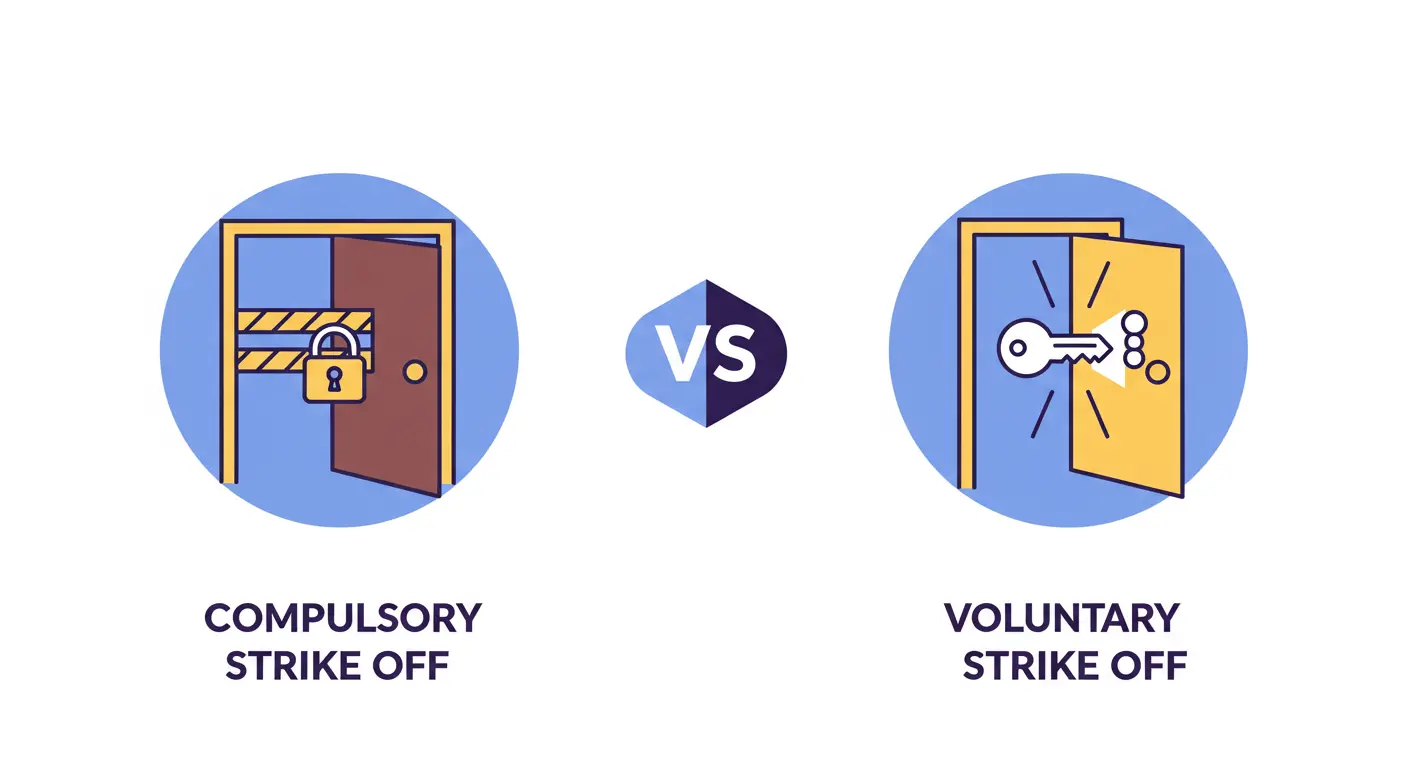Directors and shareholders can feel anxious about the next step when it comes to closing a business. There are many legal and financial concerns that come with this decision. You may be facing a First Gazette Notice for Compulsory Strike Off, or you might consider a Voluntary Striking Off to close your company smoothly.
It is important to understand the difference between Compulsory vs Voluntary Strikes to protect your assets and comply with the Companies Act 2006, as well as avoid any penalties. The guide compares and explains both methods of dissolution and their impact on employees, creditors, and HMRC. This article will help you avoid costly mistakes and make the right decisions, whether you are dealing with noncompliance or planning to close your company.
What does compulsory strike-off mean?
Companies House can force a company into dissolution due to legal infractions. The Registrar of Companies initiates the process under Section 1000 of the Companies Act 2006. The process starts when the company does not meet its statutory obligations, such as filing a tax return or an annual account. A First Gazette Notice for mandatory strike off is issued when a company fails to comply with statutory obligations, such as failing to respond to or settle tax debts or communications from Companies House.
It has 2 months to reply; otherwise, it will be dissolved and its assets will become bona vacantia. In the event of negligence by directors, they may be charged with criminal offenses, and their creditors could lose access to recovery. The process can disrupt employees as well as shareholders. It is important to take action quickly in order to avoid serious consequences.
Understanding Voluntary Strike Off
The Voluntary Strike Off is a way for a business to stop operating voluntarily. It’s controlled by the directors and governed by sections 1004 and 1005 of the Companies Act 2006. For the company to qualify, it must not have traded or sold any stock within the past 3 months. It must also be free of all debts and receive shareholder approval.
The Director submits a DS01 to Companies House and notifies creditors, HMRC, trustees, and employees within 14 days. The voluntary Gazette is then published, and a 2-month period of objections follows. The Final Gazette will confirm dissolution if approved. The final Gazette confirms dissolution if approved.
Why Would a Company Choose Voluntary Strike Off?
When they have achieved their goal, companies choose Voluntary Strike Off as a way to close efficiently. This is a more straightforward alternative to liquidating if you have no debts. This is the option directors choose when a company has stopped trading and has no stock, and all taxes and liabilities have been settled. Notifying creditors, HMRC, and shareholders within 14 days is part of the Voluntary Strike Off requirements. The process outlined by Sections 1004 & 1005 avoids forced dissolution and shields directors against legal risk.
It’s not a compulsory removal of the company, but a proactive decision, usually driven by retirement or restructuring. Companies can ensure transparency by publishing a Gazette notice. This allows a 2-month window for any objections before dissolution.
Consequences for Compulsory Strike Off
The consequences of a compulsory strike-off are severe, both financially and legally. It is triggered by noncompliance and dissolves the business, with assets transferred to bona vacantia. If directors fail to respond to Companies House communications or file their accounts, they may be charged with criminal offenses. Dissolution stops legal actions, so creditors struggle to collect debts. If HMRC is not paid, employees may lose their pensions or wages. Investors will lose money if assets are not distributed. The first Gazette Notice for Compulsory Strike-Off signals that there is a two-month period to take action, otherwise the Final Gazette confirms closure. The process can damage reputations and make future ventures more difficult. To avoid harsh penalties, companies must resolve tax issues and Company Tax returns promptly.
How to Avoid Compulsory Strike Off?
By addressing the noncompliance immediately, you can stop the Compulsory Strike Off. Companies House sends a First Gazette notification when tax or filing obligations have not been met, allowing a 2-month period to take action. Submit all overdue company tax returns and financial statements immediately to prevent dissolution. Resolve issues such as unpaid taxes or HMRC debts by responding to communications from the Registrar of Companies. Directors must monitor deadlines for compliance and keep clear records.
Consider a voluntary strike off if trading has stopped to prevent forced closure. By seeking professional guidance, you can ensure that the rules of Companies House are followed and protect directors from fines as well as creditors. Active steps like updating shareholders’ details or settling debts can stop a proposal for strike off and keep the legal status of the company.
Key Difference Between Compulsory vs Voluntary Strike-Off
Compulsory vs voluntary strikes-off are distinct ways to close a company, and they have different processes and impacts. The Compulsory Strike Off is a result of noncompliance with Companies House and the risk of penalties. A Voluntary Strike Off, on the other hand, follows requirements set out by a Voluntary Strike Off for a controlled departure. This difference impacts directors, assets, and creditors. This is the easiest to find.
| Aspect | Compulsory Strike Off | Voluntary Strike Off |
|---|---|---|
| Initiator | Non-compliance leads to a Registrar at Companies House initiating disciplinary action. | The directors of the company begin the dissolution procedure. |
| Reasons | Failure to respond to a communication, file a Company Tax Return or Accounts, etc. | When the company ceases trading or achieves its goal, it is selected for strategic closure. |
| The Process | First Gazette Notice for Compulsory Strike Off, and a 2-month period in which to reply. | DS01 Form submitted, Gazette Notice published voluntarily, 2 months objection period. |
| Liabilities | Taxes, wages, and debts that are not resolved can complicate creditor recovery. | The voluntary strike-off requirement requires that all liabilities be canceled. |
| Director Risk | Companies Act 2006 regulations that are violated could result in a criminal offense or disqualification. | Companies House's strike-off rules can be followed with minimal risk. |
| Asset Outcome | After the Final Gazette dissolved by compulsory striking off, the assets became bona vacant. | If liabilities are cleared, assets can be distributed to the shareholders. |
| Notice to Stakeholders | There is no formal notification requirement for employees or creditors during the entire process. | Employees and HMRC will be notified of the DS01 within 14 days. |
| Complexity | Often, the involuntary removal of directors is linked with compulsory company removal. | With clear criteria, controlled liquidation is simpler and easier than voluntary. |
| Results | Directors face financial and legal penalties if they are forced to dissolve their company. | If the Voluntary Strike Off requirements are met, there is no penalty for a clean closure. |
| Restorative Possibility | It is possible to restore the struck-off company through the court, but it's expensive and complicated. | Closure is usually planned and in compliance. |
Impact On Directors And Stakeholders
Directors and stakeholders are affected differently by compulsory vs voluntary strikes off. Directors who do not comply with the compulsory strike-off risk being charged criminally, fined, or even disqualified. Employees risk not being paid, creditors lose their recovery options, and investors lose their investment as assets are declared bona vacantia. Directors maintain control in a voluntary strike off by settling all liabilities, notifying HMRC, and the trustees. If obligations are paid, employees and creditors will be protected. Investors can receive distributions of assets. The Companies Act 2006 requires transparency for both procedures. Compulsory striking off can damage reputations, while voluntary strikes off maintain trust. Directors need to act quickly in order to prevent First Gazette Notice issues and comply with Companies House.
Restoring a Struck-Off Company
If the company is dissolved, you can restore it through a formal procedure. Companies House permits restoration in 6 years. This requires court approval and the settlement of liabilities such as tax or debt. This process includes filing late Company Tax returns, paying fines, and dealing with HMRC claims or creditors. The directors must show that the dissolution of their company was unfair, usually due to noncompliance. The restoration process is complex and expensive, as opposed to the simple Voluntary Strike Off requirement. Assets are returned to shareholders and employees, but Bona Vacantia cases complicate the situation. Consultations with professionals can ensure compliance with Companies House’s strike-off regulations, which will avoid further penalties. Businesses with pension and creditor problems can restore their status, but proactive compliance will prevent this.
Role of the Company House in Strike Off
Companies House supervises the voluntary and compulsory strike-off processes. The Companies Act 2006 is enforced by the Registrar of Companies, who issues First Gazette Notices in cases of noncompliance and approves voluntary Gazette Notices. Companies House checks filings, communication, and tax submissions for compulsory strike-off. A 2-month notice of dissolution is issued if the company fails to comply. Companies House checks eligibility for voluntary strikes off and ensures there are no liabilities or stock transactions.
Within 14 days, directors must inform creditors, HMRC, and shareholders. Companies House’s strike-off rules ensure transparency by publishing notifications to protect all stakeholders. Compliance is important because noncompliance can lead to criminal charges, but noncompliance will result in a closure. To avoid being forced to dissolve and keep their good standing, businesses must be aware of the deadlines for filing Company Tax returns.
Conclusion
Directors who want to shut down their business without financial or legal pitfalls must understand the difference between a compulsory and voluntary strike off. The Compulsory Strike Off is triggered when a company fails to comply with Companies House rules or HMRC regulations. This can result in criminal charges, asset forfeiture, and difficulties for employees and creditors.
A voluntary strike off, on the other hand, offers a compliant, controlled closure that ensures liabilities such as tax and wages have been settled. Directors can choose between Voluntary strike-off and voluntary liquidation by understanding the Companies House rules for strike-off. This will help them avoid First Gazette Notices. Compliance with the Companies Act 2006 is essential to protect shareholders and preserve trust.
For tailored advice, contact Xact+ Accountants, and consult with experts to help ensure that the dissolution of your company is a seamless process. Act now to protect your company’s legacy.
















